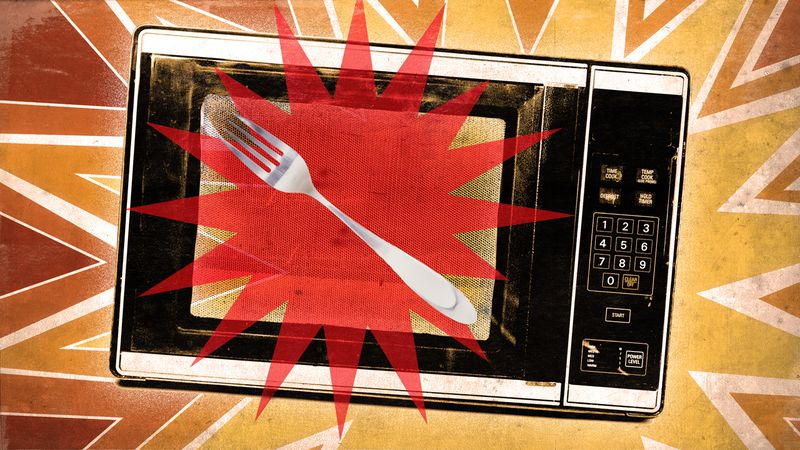We Asked A Physicist: Why Can't We Put Metal In The Microwave?
At a young age, we learned the golden rule of America's favorite convenience appliance: never put metal in the microwave. But why? What would happen? Will it really burn the whole house down like Mom says?
Before we start breaking the rules, let's look at how a microwave oven—at least one that isn't filled with forks—cooks. It's a two-step process. The oven first produces a type of light called a "microwave," which wiggles with just the right frequency to make water molecules in your food vibrate or spin around like tops. Then, as the water rotates, it bangs into its neighbors and dumps that energy into the rest of your meal in the form of heat. Since the food we eat is mostly water, microwave cooking is a fast, efficient process.
When it comes to metals though, the wiggling microwaves don't find any easily excited water droplets, so there's no good way to turn that wave energy into heat. Instead, two different things happen. A little bit of the wave energy shuffles the loose electrons on the surface of the metal around, and the rest of the wave simply gets reflected. In that way, a sheet of aluminum foil works more like a microwave mirror than a microwave sponge. Metal in a microwave absorbs so little energy that it doesn't even get warm to the touch.
Okay... so where's the problem?
First, if there's nothing but metal in the microwave, you're left with a lot of mirrors and no absorbers. Pumping more and more energy into the box with nowhere for it to go leads to waves that reinforce each other and build in amplitude. As you run longer, the waves bouncing around grow like a tidal wave approaching shore and eventually get big enough to "cook" the oven's internal circuits.
Second, if the metal you put in the microwave is pointed (like a fork), has sharp corners (like crumpled aluminum foil), or is thin (like the decorative gold on your fancy teacup), then the electrons moved around by the microwaves can bunch up along the edges. When too much charge builds in one spot, those electrons get very unhappy. And unhappy electrons are liable to—zap!—jump through the air to find a better spot. (That static electric shock you get by shuffling across the carpet and touching a doorknob? Same thing.) While a little bit of sparking between the tines of a fork probably won't cause long-term damage, larger sparks between the metal and the case are where the trouble starts. Throw a little bit of paper or something flammable in there, and your mother's fiery disaster prediction will come true.
So is it safe to use any metal at all in the microwave? Well, you might not have noticed, but there already is a bunch of metal in your microwave. The walls and circuitry are mostly metal, and the door has a mesh built in that lets visible light out, but reflects microwaves back in. This shielding is important. Not only are your leftovers mostly made of water, but so are you, and it'd be a drag to cook yourself before the meatloaf's done. (Microwave burns are a real thing, but you have to turn to fiction if you want extreme microwave havoc: Infinite Jest tells of a grisly head-in-microwave suicide.) On a smaller scale, faulty shielding can lead to microwave bursts strong enough to fool radio telescope astronomers.
If you must put metal in your microwave—your house, your rules—the safest option is flat, non-crinkled aluminum foil. With few sharp corners, the electrons have a large area to vibrate over and not many places to get stuck. Sparking isn't a problem, and the microwave reflections can shield food and keep it cool, like a blanket over a chicken bone you want to protect from burning. Limit yourself, though. The USDA suggests covering no more than one quarter of your food, keeping excess reflections at bay. Thin, flat foils are also part of "crisper" packaging like Hot Pocket sleeves and frozen pizza trays. These foils reflect microwaves, concentrating the energy nearby and cooking the crust a bit more than the rest. (It's all relative, though. You're never going to get a nice sear on a microwaved steak, crisper foil or not.)
Beyond that, be wary. Spoons are smoother than forks and should lead to less sparking, and a metal mixing bowl might likewise be cornerless enough, but when you're explaining what happened to the insurance claims officer, don't say you heard that justification here.
